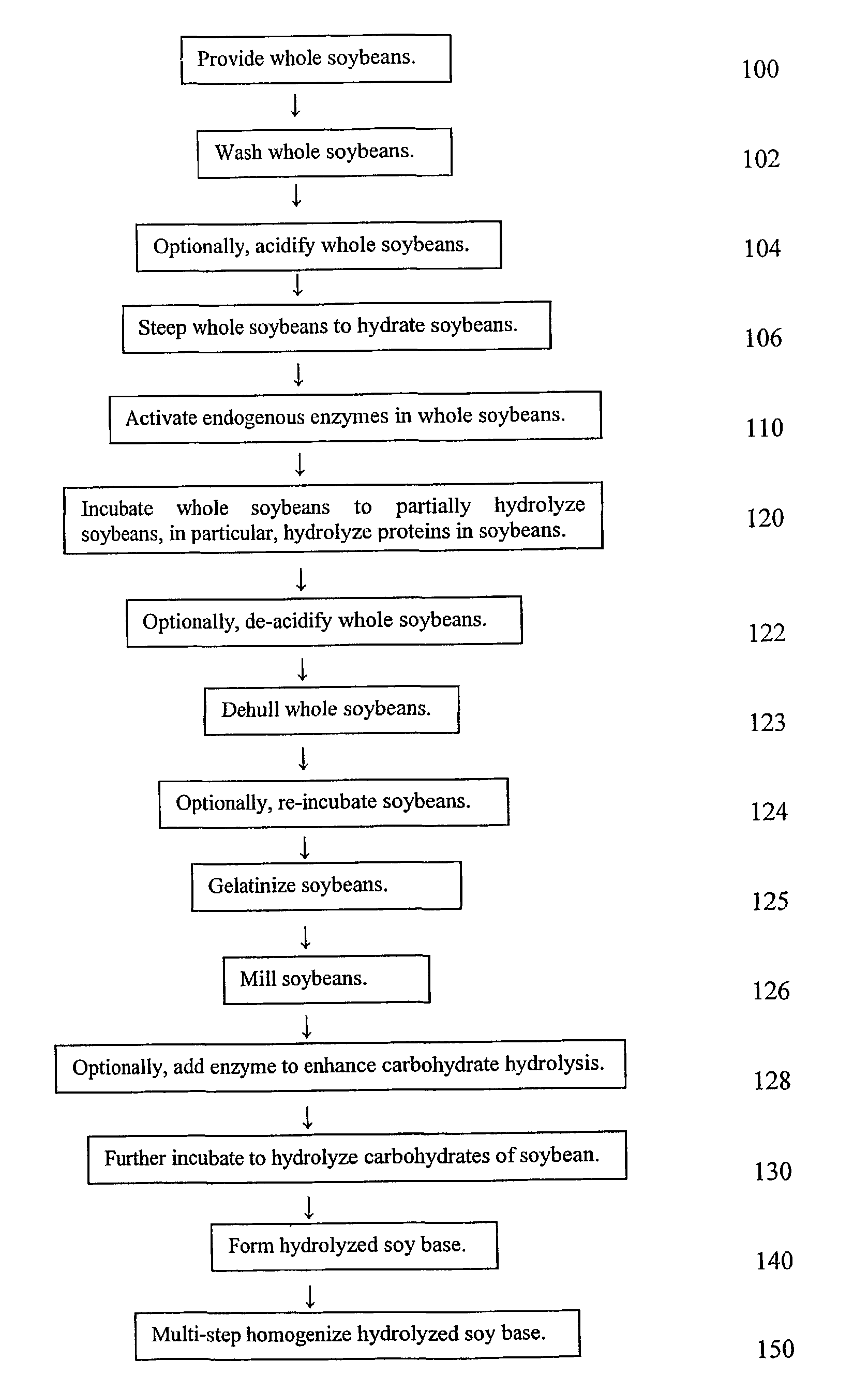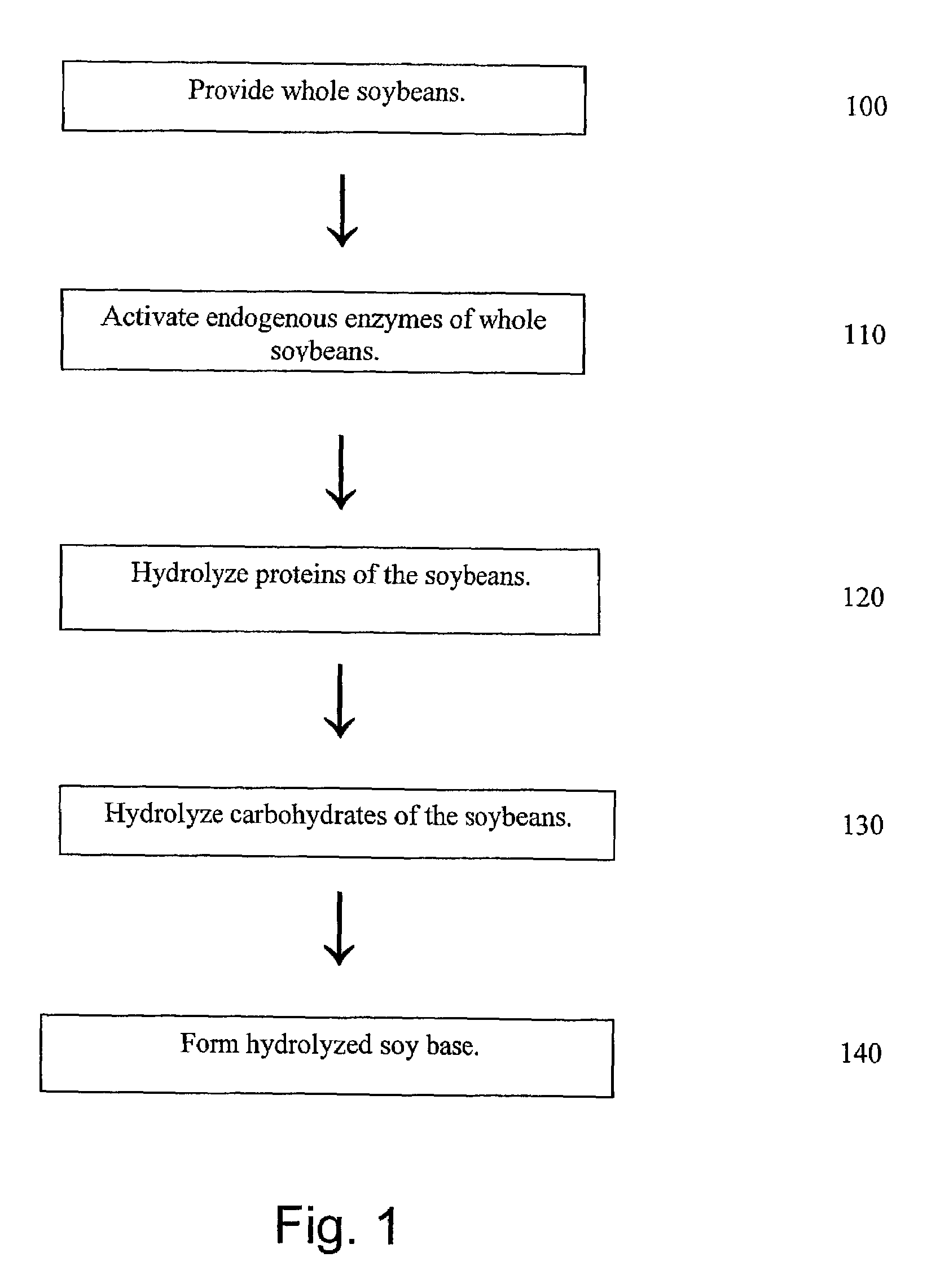Soy base and related method of manufacture
a soy base and related technology, applied in the field of soy products, can solve the problems of inadequate enzymes, reduced visual appeal of resultant soy beverages, and difficult to digest soy beverages created with conventional processes, and achieve the effect of lack of chalky textur
- Summary
- Abstract
- Description
- Claims
- Application Information
AI Technical Summary
Benefits of technology
Problems solved by technology
Method used
Image
Examples
example i
A. Example I
[0076]A soy beverage manufactured from hydrolyzed dehulled-whole soybeans according to a process of the present invention was analyzed to determine the nutritional values of the beverage. The sample analyzed was 240 ml and included the ingredients in the amounts noted in Table I, titled “Ingredients of Example I.”
[0077]
TABLE IIngredients of Example 1IngredientsPercent AddedSoymilk base solids12Sucrose3Fructose2Sea salt0.001Xantham gum0.005Guar Gum0.005Lecithin0.01Flavor0.5Color0.2
[0078]Table II below, “Nutritional Facts for Example I,” sets forth the measured composition of the hydrolyzed beverage as would be required on “nutrition facts” labels for food by the United States Food & Drug Administration.
[0079]
TABLE IINutritional Facts for Example IAmount PerAmount PerNutrient100 gServing% Std. Per SvgBasic ComponentsCalories53129.85Protein3.36g8.23g16% Carbohydrates5.04g12.35g4%Dietary Fiber1g2.45g10% Sugar - Total4.58g11.22gFat - Total2.19g5.37g8%Saturated Fat0.31g0.76g4%...
example 2
B. Example 2
[0099]A soy beverage was manufactured from hydrolyzed dehulled-whole soybeans of different varieties according to the process of the present invention. The soy beverage was analyzed to determine the effect of soybean viability on soy beverage quality. Six specific food / beverage grades cultivars of varying viability were selected for the analysis, including soybean cultivars that are identified by the names Iowa 3006, Callahan 5200, Iowa 2025, Vinton 81, Ohio-Vinton 81 and Wisconsin 2750, available from Thumb Oilseeds Producers Cooperative, Ubly, Mich., United States of America. As will be appreciated, the viability of other soybean cultivar samples may be tested and used to manufacture the hydrolyzed soybean base of the present invention as desired.
[0100]In the viability test, the viability of each variety was calculated. To do this, each of six batches of different varieties was soaked for 12 hours in tap water of pH of about 7.2 and at about 20°±2° C. to hydrate the so...
example 3
C. Example 3
[0106]A soy beverage manufactured from hydrolyzed dehulled-whole soybeans according to process of present invention was tested to determine the effect of acid steeping of soybeans on processed soy beverage quality.
[0107]In the test, three kilograms each of two food / beverage soybean cultivars, EC 1 and HP 204, available from Soyatech, Inc., Bar Harbor, Me., United States of America were washed and put into tap water. The pH of the water was adjusted from 7.2 to 2.0 with 50% concentrated food-grade citric acid available from FBC Industries of Rochelle, Ill. Immediately thereafter, the beans were steeped at 32°±2° C. for about four hours. Steeping was repeated for the two soybean cultivars at pH 3.0, pH 4.0 and pH 5.0 for the same time and temperature as above, but the concentration of citric acid added was manipulated.
[0108]After steeping was complete, the steep liquor was drained and the soybeans were incubated at about 32°±20° C. for 18 hours. After incubation, seed viab...
PUM
| Property | Measurement | Unit |
|---|---|---|
| constant temperature | aaaaa | aaaaa |
| inlet temperature | aaaaa | aaaaa |
| constant temperature | aaaaa | aaaaa |
Abstract
Description
Claims
Application Information
 Login to View More
Login to View More - R&D
- Intellectual Property
- Life Sciences
- Materials
- Tech Scout
- Unparalleled Data Quality
- Higher Quality Content
- 60% Fewer Hallucinations
Browse by: Latest US Patents, China's latest patents, Technical Efficacy Thesaurus, Application Domain, Technology Topic, Popular Technical Reports.
© 2025 PatSnap. All rights reserved.Legal|Privacy policy|Modern Slavery Act Transparency Statement|Sitemap|About US| Contact US: help@patsnap.com



